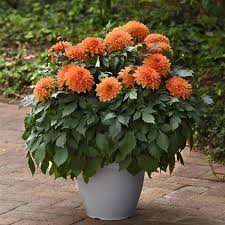1
/
of
1
Dahlia, Dalaya Apricot
Dahlia, Dalaya Apricot
Dahlia Dalaya Apricot is a stunning variety of dahlia that features large, semi-doubled blooms in warm apricot, peach, and soft orange hues. The flowers are often described as having a soft, romantic look, with petal shapes that radiate outward in a graceful, almost tiered arrangement. The plant's compact size makes it ideal for smaller spaces, yet it still provides impressive blooms that bring vibrant color to gardens, containers, and cut flower arrangements.
Plant Characteristics:
- Height: Typically grows to a height of 12-18 inches (30-45 cm), making it a relatively short dahlia variety.
- Width: It has a spread of about 12-18 inches (30-45 cm), creating a bushy and full appearance.
- Flowers: The blooms are large, with a semi-doubled form, and come in warm apricot tones, which can sometimes appear almost peach or light orange. Each flower can measure about 3-4 inches (7-10 cm) in diameter.
- Foliage: The foliage is deep green and slightly serrated, providing a nice contrast to the soft tones of the flowers.
Growing Zones:
- Hardiness Zone: Dahlia Dalaya Apricot is typically grown as a tender perennial in USDA Hardiness Zones 8-11, although in colder climates (zones 3-7), it is often treated as an annual or dug up and overwintered indoors to protect from frost.
Light Requirements:
- Full sun: Dahlias thrive in full sunlight and require at least 6-8 hours of direct sunlight per day to produce optimal blooms and strong growth.
Soil:
- Prefers well-draining, fertile, and slightly acidic soil (pH 6.0-6.5). The soil should be rich in organic matter, such as compost, to ensure healthy growth and abundant blooms. Avoid heavy, clay-like soils that retain water, as dahlias are prone to root rot in soggy conditions.
Watering:
- Dahlias like consistently moist soil, but they do not like being waterlogged. Water the plant regularly, especially during dry periods, but make sure the soil drains well to prevent water from pooling around the roots. It's best to water deeply and less frequently rather than shallow watering that can encourage surface roots.
Uses:
- Ornamental plant: Dalaya Apricot is perfect for adding vibrant color and structure to garden beds, borders, or containers. Its compact size makes it ideal for smaller spaces or even as a patio plant.
- Cut flowers: The beautiful apricot blooms are perfect for cut flower arrangements, bringing a soft, warm touch to bouquets and floral displays.
- Mixed borders or flower beds: It pairs well with other annuals or perennials, adding a soft pop of color without overwhelming larger plantings.
Native Range:
- Native to Mexico and Central America. Dahlias are originally from the mountainous regions of Mexico and Central America, where they are perennial in their native environment. In most parts of the world, including the U.S., they are grown as annuals or dug up to be stored indoors over winter.
Tips for Growing Dahlia Dalaya Apricot:
- Planting: When planting Dalaya Apricot, space the plants 12-18 inches apart to allow for proper airflow and growth. If growing from tubers, plant them after the last frost date in your region.
- Staking: Dahlias may require staking to keep their stems upright, especially if the flowers are large or the plant gets top-heavy. Place the stake at planting time to avoid damaging the roots later.
- Deadheading: Regularly remove spent blooms (deadheading) to encourage more flowering throughout the season.
- Fertilizing: Use a balanced fertilizer every few weeks during the growing season to promote healthy growth and blooming. Avoid over-fertilizing with nitrogen, as this can lead to more foliage but fewer flowers.
- Overwintering: In colder climates, dig up the tubers after the first frost, dry them, and store them in a cool, dry location until the next spring. In warmer climates, you can leave the tubers in the ground if the winter is mild.
Regular price
$6.98 USD
Regular price
Sale price
$6.98 USD
Unit price
/
per
Shipping calculated at checkout.
Couldn't load pickup availability


